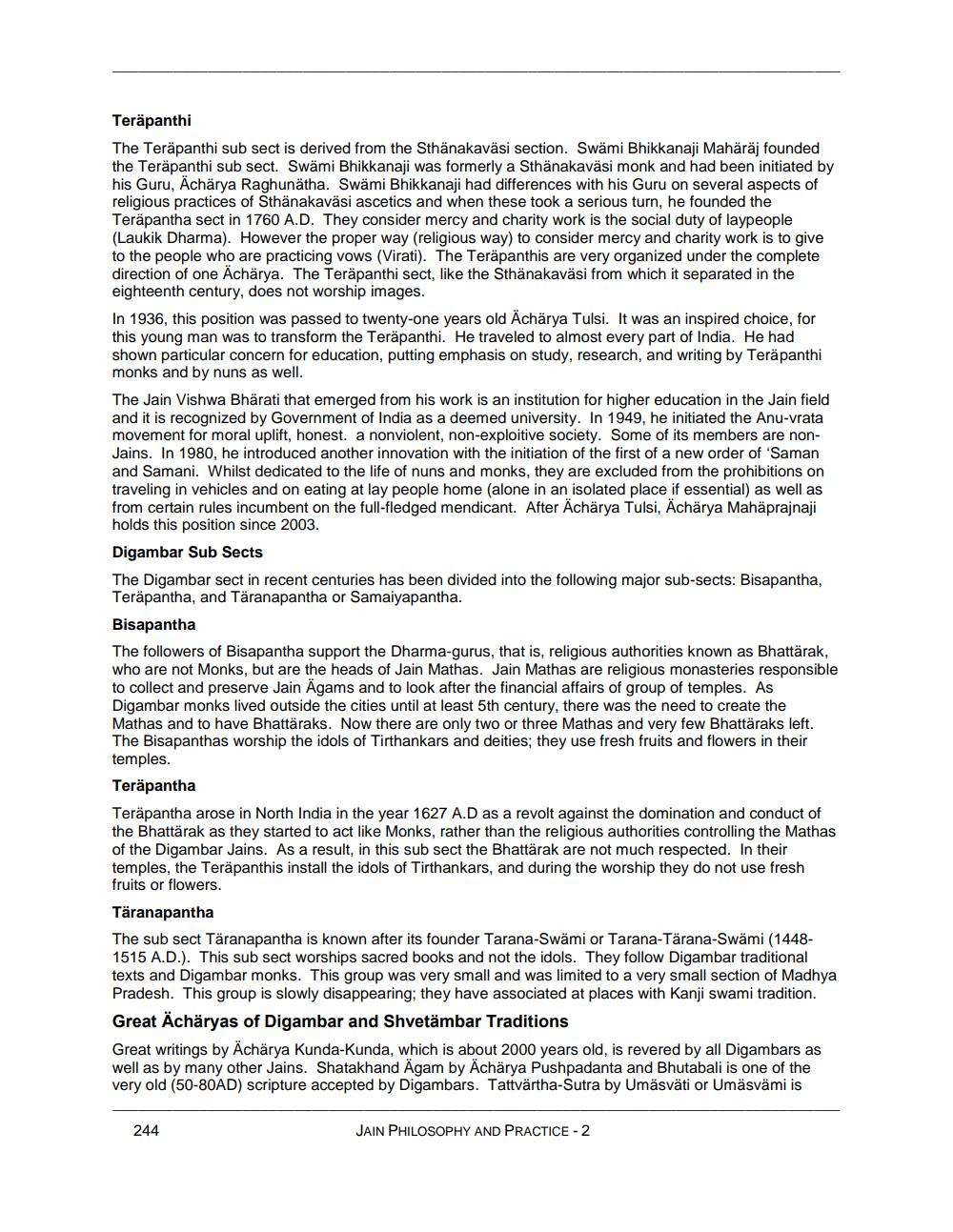________________
Teräpanthi The Teräpanthi sub sect is derived from the Sthänakaväsi section. Swami Bhikkanaji Mahäräj founded the Teräpanthi sub sect. Swami Bhikkanaji was formerly a Sthänakaväsi monk and had been initiated by his Guru, Acharya Raghunatha. Swami Bhikkanaji had differences with his Guru on several aspects of religious practices of Sthänakaväsi ascetics and when these took a serious turn, he founded the Teräpantha sect in 1760 A.D. They consider mercy and charity work is the social duty of laypeople (Laukik Dharma). However the proper way (religious way) to consider mercy and charity work is to give to the people who are practicing vows (Virati). The Teräpanthis are very organized under the complete direction of one Acharya. The Teräpanthi sect, like the Sthänakaväsi from which it separated in the eighteenth century, does not worship images. In 1936, this position was passed to twenty-one years old Acharya Tulsi. It was an inspired choice, for this young man was to transform the Teräpanthi. He traveled to almost every part of India. He had shown particular concern for education, putting emphasis on study, research, and writing by Teräpanthi monks and by nuns as well. The Jain Vishwa Bhärati that emerged from his work is an institution for higher education in the Jain field and it is recognized by Government of India as a deemed university. In 1949, he initiated the Anu-vrata movement for moral uplift, honest. a nonviolent, non-exploitive society. Some of its members are nonJains. In 1980, he introduced another innovation with the initiation of the first of a new order of 'Saman and Samani. Whilst dedicated to the life of nuns and monks, they are excluded from the prohibitions on traveling in vehicles and on eating at lay people home alone in an isolated place if essential) as well as from certain rules incumbent on the full-fledged mendicant. After Acharya Tulsi, Acharya Mahaprajnaji holds this position since 2003. Digambar Sub Sects The Digambar sect in recent centuries has been divided into the following major sub-sects: Bisapantha, Teräpantha, and Taranapantha or Samaiyapantha. Bisapantha The followers of Bisapantha support the Dharma-gurus, that is, religious authorities known as Bhattärak, who are not Monks, but are the heads of Jain Mathas. Jain Mathas are religious monasteries responsible to collect and preserve Jain Agams and to look after the financial affairs of group of temples. As Digambar monks lived outside the cities until at least 5th century, there was the need to create the Mathas and to have Bhattaraks. Now there are only two or three Mathas and very few Bhattaraks left. The Bisapanthas worship the idols of Tirthankars and deities; they use fresh fruits and flowers in their temples. Teräpantha Teräpantha arose in North India in the year 1627 A.D as a revolt against the domination and conduct of the Bhattarak as they started to act like Monks, rather than the religious authorities controlling the Mathas of the Digambar Jains. As a result, in this sub sect the Bhattarak are not much respected. In their temples, the Teräpanthis install the idols of Tirthankars, and during the worship they do not use fresh fruits or flowers. Täranapantha The sub sect Täranapantha is known after its founder Tarana-Swami or Tarana-Tarana-Swami (14481515 A.D.). This sub sect worships sacred books and not the idols. They follow Digambar traditional texts and Digambar monks. This group was very small and was limited to a very small section of Madhya Pradesh. This group is slowly disappearing; they have associated at places with Kanji swami tradition. Great Acharyas of Digambar and Shvetämbar Traditions Great writings by Acharya Kunda-Kunda, which is about 2000 years old, is revered by all Digambars as well as by many other Jains. Shatakhand Agam by Acharya Pushpadanta and Bhutabali is one of the very old (50-80AD) scripture accepted by Digambars. Tattvärtha-Sutra by Umäsväti or Umäsvämi is
244
JAIN PHILOSOPHY AND PRACTICE -2




